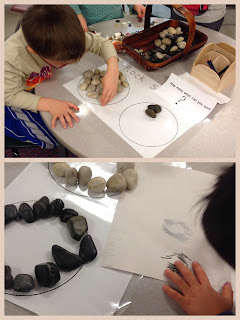We got together as a group to
discuss all the things we've learned so far from observing our hermit crabs and
researching our wonder questions using various non-fiction books we found at
the library.
What we've learned so far about hermit crabs...
"They use their pincers to
feel the food and put it to their mouths with their tentacles and eat it."
A.M.
"If they don't have food,
they will not feel so good and they might die.
They need to be healthy to stay alive." G.M.
"They eat vegetables like
carrots, celery, lettuce, and fruit."
C.D.
"If they get too big, they
have to find a new home and a bigger shell." R.W.
"They use their claws to take
off the shell and change to another shell" E.H.
"They have plants in their
tank so they think it is the bottom of the ocean." C.M.
"Like coral" R.W.
"shells" C.M.
"sand" M.P.
"kelp" A.M.
"seaweed" E.H.
"They change shells because
they get too big for the little shell and they have to find a new shell or they won't be able to get out
because they will be too big." R.W.
"They walk on 4 spindly
legs." W.E.
“They
have an exoskeleton on the outside of their skin.” G.M.
“We have
to make sure their habitat is between 80 and 85 degrees!” E.S.
“They
molt, they go under the sand. Then they
grow, and then they get a new exoskeleton.” G.B.
“They
have gills for breathing.” B.S.
“After
they grow, they look for a new shell.” N.S.
“We have
to make sure their habitat is moist by spraying water.” O.S.
“They
bath in the salt water like the ocean.” D.S.
“They
like to climb seaweed.” R.W.
“They
eat with their pincers.” W.E.
“I saw
one swimming in the salt water.” C.D.
“They
snap their claws to talk.” E.H.
“When
they go under the sand, their exoskeleton breaks.” E.E.
“They
are nocturnal.” A.M.
“They
eat lettuce.” P.I.
“I saw
them drinking water.” D.C.
“Molting
is when they shed their exoskeleton.” D.S.
“The bones
of the hermit crab are on the outside.” G.M.
“They
have a shell to protect them from animals that want to eat them.” G.M.
“They
are getting their new shape then going to get a new shell.” A.T.
“They
need a new shell because they grew out their old one.” K.W.
We used plasticine and sketch
drawings to support and demonstrate our learning!
"First I made the shell, then I made the hermit crab. These are the pincers and these are the legs, and the eyes, and then the tail for protecting its shell." K.E.
Daily observations of our hermit crabs…
“I saw the hermit crab and he
was burying himself and the shell was still on.” E.E.
“I saw them dig a hole under
the sand.” H.S.
“I saw that the hermit crabs
were snapping their pincers.” A.P.
“When I was looking at the
hermit crabs, I saw that Shelley and Crusty were having a race.” G.B.
“I saw that one of the hermit
crabs was eating using his pincers.” W.E.
“I see that Crabby is gone in
the sand.” E.S.
“I see Crabby is eating
fruit.” G.B.
“I heard a hermit crab snap
its claws.” E.H.
“He is using his pincers.” E.E.
“I see that the hermit crab
bent the grass.” W.E.
“The hermit crab was eating.” K.E.
“Only Crabby is in the shell.” D.S.
“I see Shelley and Crabby
still wet.” E.E.
“Shelley is digging.” O.S.
“I see that Shelley and
Crusty are in the food.” E.H.
“There are two shells turned
over.” A.P.
“I see that Shelley is
hiding.” G.B.
"I saw
that the hermit crab was climbing the grass.” E.H.
“I saw that hermit crab
sleeping.” G.M.
“I see two shells flipped
over.” G.B.
“I see only one hermit crab.” E.S.
“It’s at 80 degrees.” C.M.
“The hermit crabs pushed out
the kale.” W.E.
“There is not much food left.” M.P.
“The thermometer is at 80.” R.W.
“I think Shelley will change
shells first because she is the biggest.” A.M.
What we still wonder about hermit crabs…
“How do hermit crabs change
shells?” P.I.
“Why do they live on land?” D.S.
“How do they breathe?” O.S.
“I wonder why they aren’t eating?” E.S.
“When are they going to
change shells?” G.B.
“How does a hermit crab walk?” H.S.
“Why are they not moving in
the day?” M.P.
“Why do they need plants?” N.S.
“I wonder how they take their
shell off?” G.B.
“How do they walk on short
legs?” C.M.
“How do they get out of the
shell?” M.P.
There's still so much to learn about our hermit crab friends!





















































